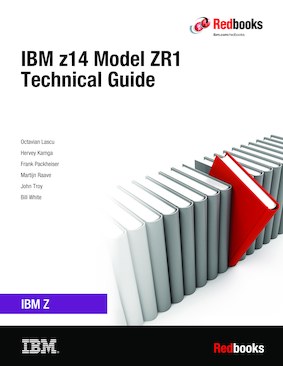Abstract
This IBM® Redbooks® publication describes the new member of the IBM Z® family, IBM z14™ Model ZR1 (Machine Type 3907). It includes information about the Z environment and how it helps integrate data and transactions more securely, and can infuse insight for faster and more accurate business decisions.
The z14 ZR1 is a state-of-the-art data and transaction system that delivers advanced capabilities, which are vital to any digital transformation. The z14 ZR1 is designed for enhanced modularity, in an industry standard footprint.
A data-centric infrastructure must always be available with a 99.999% or better availability, have flawless data integrity, and be secured from misuse. It also must be an integrated infrastructure that can support new applications. Finally, it must have integrated capabilities that can provide new mobile capabilities with real-time analytics that are delivered by a secure cloud infrastructure.
IBM z14 ZR1 servers are designed with improved scalability, performance, security, resiliency, availability, and virtualization. The superscalar design allows z14 ZR1 servers to deliver a record level of capacity over the previous IBM Z platforms. In its maximum configuration, z14 ZR1 is powered by up to 30 client characterizable microprocessors (cores) running at 4.5 GHz. This configuration can run more than 29,000 million instructions per second and up to 8 TB of client memory. The IBM z14 Model ZR1 is estimated to provide up to 54% more total system capacity than the IBM z13s® Model N20.
This Redbooks publication provides information about IBM z14 ZR1 and its functions, features, and associated software support. More information is offered in areas that are relevant to technical planning. It is intended for systems engineers, consultants, planners, and anyone who wants to understand the IBM Z servers functions and plan for their usage. It is intended as an introduction to mainframes. Readers are expected to be generally familiar with IBM Z technology and terminology.
Table of Contents
Chapter 1. Introducing the new IBM Z family member: IBM z14 Model ZR1
Chapter 2. Central processor complex hardware components
Chapter 3. Central processor complex system design
Chapter 4. Central processor complex I/O system structure
Chapter 5. Central processor complex channel subsystem
Chapter 6. Cryptographic features
Chapter 7. Operating system support
Chapter 8. System upgrades
Chapter 9. Reliability, availability, and serviceability
Chapter 10. Environmental requirements
Chapter 11. Hardware Management Console and Support Elements
Chapter 12. Performance
Appendix A. IBM Secure Service Container framework
Appendix B. Channel options
Appendix C. Native Peripheral Component Interconnect Express
Appendix D. Shared Memory Communications
Appendix E. IBM Dynamic Partition Manager
Appendix F. IBM zEnterprise Data Compression Express
Appendix G. 16U Reserved feature
